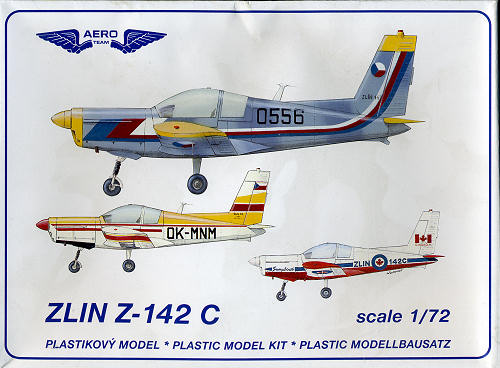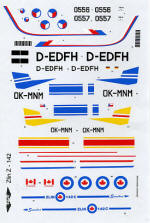
| KIT: | Aero Team 1/72 Zlin Z-142C |
| KIT #: | 7204 |
| PRICE: | I forget, but it was around $15.00 |
| DECALS: | Four options |
| REVIEWER: | Scott Van Aken |
| NOTES: | Treat it as short run. |

| HISTORY |
The Zlin Z 142 is a single-engine two-seat Czechoslovakian trainer aircraft manufactured by Moravan Otrokovice. The Z 142 is the most popular aircraft variant in its aircraft line, with the base model being the Z 42. In contrast to the older Z 40 which had both seats in tandem, all Z 42 series aircraft use side-by-side seating.
The aircraft were built by Moravan Aviation, founded in 1934 in aviation by Tomas Bata in the Czech Republic.
The aircraft fuselage center section is of welded steel tube, covered with sheet metal and fiberglass panels. The tailcone is of monocoque construction. The empennage is of sheet metal, and incorporates an all-flying tail. The two-spar wings are of all-metal construction. The tricycle landing gear is fixed, with a steerable nose wheel. The Z 42 is powered by a Walter inverted six-cylinder engine rated at 134 kW (180 hp).
The prototype Z-142 first flew on December 28, 1978.
The Zlin Z 142 is a development of the Zlin Z 42 M platform, equipped with a Walter (now LOM) fuel-injected inverted 6 cylinder, supercharged air-cooled engine rated at 157 kW (210 hp), driving a constant speed propeller.
Designed for aerobatics instruction, it was certified to +6.0 and -4.0 limit maneuvering load factors, and was equipped with full inverted fuel and oil systems permitting extended inverted flight.
In the late 1980s further development work was initiated. The inverted inline engine was replaced with a four-cylinder horizontally-opposed Lycoming IO-360 engine. This variant is designated the Z 242, and is immediately distinguishable by its relatively wide cowling which houses the flat-four engine.
The Z 42 variants are used for basic and intermediate VFR flight training, for basic aerobatics training, for night and instrument flight training, and for glider towing.
The aircraft were largely used in former COMECON countries for air club and basic air force training. It was also used by the air forces of Algeria, Mexico, Macedonia, and Slovenia. According to the Tamil Eelam Airforce, it was used in bombing sorties on the Sri Lankan air force bases in occupied Tamil Eelam and southern Sri Lanka.[ http:www.theaustralian.news.com.au/story/0,20867,21672616-2703,00.html ]
There have been wing difficulties resulting in restriction of permitted aerobatic flight time for original aircraft. The factory offers a retrofit package of replacement wings and an AMU-1 fatigue monitoring system, which extends overall airframe life to 5 500 hours, all of which may be aerobatic.
| THE KIT |
 Made
in the Czech Republic, this kit looks very much like many of its contemporaries.
The detailing is finely engraved and well done. The edges appear quite crisp
compared to some even newer kits where it is more rounded or 'soft'. The single
sprue has relatively large connections, so one will need to take care when
removing the somewhat soft plastic. Although not a ton of parts, the folks at
Aero Team seem to have missed including the very distinctive control sticks.
Making these will not be a simple task, though one could probably just put in
some straight sticks as few will realize the glitch.
Made
in the Czech Republic, this kit looks very much like many of its contemporaries.
The detailing is finely engraved and well done. The edges appear quite crisp
compared to some even newer kits where it is more rounded or 'soft'. The single
sprue has relatively large connections, so one will need to take care when
removing the somewhat soft plastic. Although not a ton of parts, the folks at
Aero Team seem to have missed including the very distinctive control sticks.
Making these will not be a simple task, though one could probably just put in
some straight sticks as few will realize the glitch.
 No
optional parts with this one. An interior that consists of a pair of seats, an
instrument panel and an aft bulkhead. A large anti-glare panel is provided.
Though there is some light detail on the instrument panel, one would probably be
better off using the paper one provided as it has more detail. The fixed landing
gear is properly scale and perhaps may not be able to handle the nose weight
required, but one will only have to wait and see. All of the wheels will need
the axle holes drilled out. A single, well molded vacuform canopy is provided. I
do wish they'd included a spare just in case. The major parts have ejector stubs
that will need removed and I found one rather broad sink area on one side of the
fin, though it will be an easy patch.
No
optional parts with this one. An interior that consists of a pair of seats, an
instrument panel and an aft bulkhead. A large anti-glare panel is provided.
Though there is some light detail on the instrument panel, one would probably be
better off using the paper one provided as it has more detail. The fixed landing
gear is properly scale and perhaps may not be able to handle the nose weight
required, but one will only have to wait and see. All of the wheels will need
the axle holes drilled out. A single, well molded vacuform canopy is provided. I
do wish they'd included a spare just in case. The major parts have ejector stubs
that will need removed and I found one rather broad sink area on one side of the
fin, though it will be an easy patch.
The instructions consist of a superbly drawn exploded view with three detail views for the instrument panel, canopy and the lower nose arrangement. Also included is an additional sheet showing various details in photos and a cutaway view of the real plane. Very much overkill in my opinion as no way will most modelers be able to use the detail information provided. Yet it is there if one wants it. Markings are provided for four aircraft. Three are shown on the color box art. First is a provisional Czech AF from November 1993. Next a civilian scheme from an aero club around 1982. The third on the box is a fake Snowbirds scheme. The fourth is a German aircraft in white with blue markings. The huge decal sheet is by Propagteam so you know it is well done and super thin.
| CONCLUSIONS |
I have found that many of these 'simple' Czech kits are actually Perdition in a box, but this one doesn't seem to look to be too bad. It is an interesting kit of an aircraft that is all over eastern Europe and now elsewhere. If your tastes are toward the different, I think this one qualifies.
| REFERENCES |
http://en.wikipedia.org
June 2008
You can bestow your thanks upon me for the kindness in providing this
one for your viewing pleasure If you would like your product reviewed fairly and quickly, please
contact
me or see other details in the
Note to
Contributors.